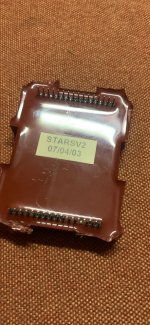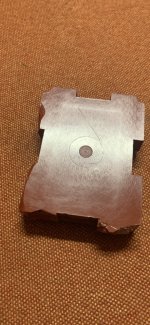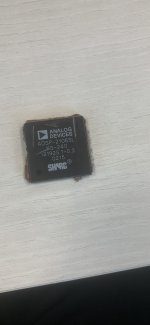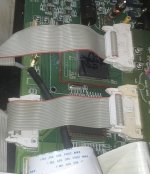AFT: receive digital signals from AKM, upsampling, cooking (this explains why it sounds very good and magical),.... then it takes digital audio out and AD1853 decodes it into analog.
If the AFT fails, the digital signal will be interrupted and cannot reach AD1853. How to know:
If the AFT fails, the digital signal will be interrupted and cannot reach AD1853. How to know:
- CDs still read normally but no sound
- When inputting an external digital signal into the DAC function, the display shows correct input information of external digital signal (as : COAXIAL, 96khz) but no sound
I have just worked on one of these for an owner who has had it since new
Aim was to replace the valves and tweak the sound to their liking
The two 6021 valves were soldered to the circuit board, with the heater wired in series from a 12V rail, which meant each valve heater had about 5.9V after loses, rather than 6.3V from the datasheet. This tends to make valves sound a little dry compared to the full voltage.
I tweaked the heater voltage regulator to give 12.6V across the valve heater
Carefully desoldered the old valves and fitted a pair of ptfe 8 pin transistor sockets which work really well with these sub miniature valves
Replaced the anode and cathode resistors with tantalum film
Replaced the 100V psu cap next to the valves with a Black Gate
Replaced the Hovland Musicaps with Duelund JDM tinned copper
Overall I would say it is a lot more colourful, richer and interesting, with a better sense of depth and width. Seems a nice player, and v flexible with the various analogue and digital inputs and outputs

Aim was to replace the valves and tweak the sound to their liking
The two 6021 valves were soldered to the circuit board, with the heater wired in series from a 12V rail, which meant each valve heater had about 5.9V after loses, rather than 6.3V from the datasheet. This tends to make valves sound a little dry compared to the full voltage.
I tweaked the heater voltage regulator to give 12.6V across the valve heater
Carefully desoldered the old valves and fitted a pair of ptfe 8 pin transistor sockets which work really well with these sub miniature valves
Replaced the anode and cathode resistors with tantalum film
Replaced the 100V psu cap next to the valves with a Black Gate
Replaced the Hovland Musicaps with Duelund JDM tinned copper
Overall I would say it is a lot more colourful, richer and interesting, with a better sense of depth and width. Seems a nice player, and v flexible with the various analogue and digital inputs and outputs
Yeah, very nice. You tuned the sound to suit the owner's taste. Nice soldering as well; the whole thing looks very professional.
You could also try different hook-up wiring.... pure copper, silver-plated copper, silver and then gold-plated copper, annealed pure silver ribbons. The choice will depend on the rest of the system and taste/subjective preference.
You could also try different hook-up wiring.... pure copper, silver-plated copper, silver and then gold-plated copper, annealed pure silver ribbons. The choice will depend on the rest of the system and taste/subjective preference.
my anagram AFT (DSP unit) die. Luckily there is a technician in Vietnam can fix it, now the CD is back to life and works well with all functions.
Attachments
Hi @redsnake
That's good work getting into the processor which is the problem most of the time for any players using the early anagram upsampling processors.
Assuming its the shark DSP that's the issue inside the processor, how did your engineer reprogram the replacement shark DSP?
I'd be very interested to find out a bit more about this.
The boards I made (Here on the first page of this thread https://www.diyaudio.com/community/threads/audio-aero-capitole-ii-not-so-special-edition.388849/post-7092139) as a swap out for the later processors are far from straight forward to integrate.
They require the 3.3v and 5v supplies, the master clock and because they replace the original DAC chip with 4 x PCM1794A, they need interfacing with the original I/V stage which is adjusted to suit. This makes the unit far from commercially viable albeit it does make an incredible difference to the player and in my opinion moves them above the Vermeer units as they only use 2 DACs in stereo mode where as these use the 4 DACs in mono mode with the output summed.
As far as I can tell the analogue circuit is pretty much the same on the Vermeer as the Aero.
Assuming the S8 processors are still available, upgrading would run to about £1500 and would not be a self install.
The other issue is the logic on most of the Aero's will mute when you use it with a 192khz source. At best you'll get "no lock" on the display but the audio is still processed 😉 Clearly the logic on the Vermeer is far more recent and gives you many more options.
That's good work getting into the processor which is the problem most of the time for any players using the early anagram upsampling processors.
Assuming its the shark DSP that's the issue inside the processor, how did your engineer reprogram the replacement shark DSP?
I'd be very interested to find out a bit more about this.
The boards I made (Here on the first page of this thread https://www.diyaudio.com/community/threads/audio-aero-capitole-ii-not-so-special-edition.388849/post-7092139) as a swap out for the later processors are far from straight forward to integrate.
They require the 3.3v and 5v supplies, the master clock and because they replace the original DAC chip with 4 x PCM1794A, they need interfacing with the original I/V stage which is adjusted to suit. This makes the unit far from commercially viable albeit it does make an incredible difference to the player and in my opinion moves them above the Vermeer units as they only use 2 DACs in stereo mode where as these use the 4 DACs in mono mode with the output summed.
As far as I can tell the analogue circuit is pretty much the same on the Vermeer as the Aero.
Assuming the S8 processors are still available, upgrading would run to about £1500 and would not be a self install.
The other issue is the logic on most of the Aero's will mute when you use it with a 192khz source. At best you'll get "no lock" on the display but the audio is still processed 😉 Clearly the logic on the Vermeer is far more recent and gives you many more options.
Hi @UV101,
Shark DSP is only CPU (as intel core i3, amd ryzen,...),
Because it's just a CPU, when it fails, replace it with same CPU and it will work again.
Anagram AFT is an embedded computer, which has a CPU (Shark) and the AT27LV020A is the eprom (it contains the OS). If the AT27LV020A is damaged, the possibility of repair is zero.
The problem when repairing AFT is how can you remove the expoxy glue without damaging the circuit and components. Fortunately, that technician successfully repaired at least 3 AFTs because it was only the CPU that was damaged
Shark DSP is only CPU (as intel core i3, amd ryzen,...),
Because it's just a CPU, when it fails, replace it with same CPU and it will work again.
Anagram AFT is an embedded computer, which has a CPU (Shark) and the AT27LV020A is the eprom (it contains the OS). If the AT27LV020A is damaged, the possibility of repair is zero.
The problem when repairing AFT is how can you remove the expoxy glue without damaging the circuit and components. Fortunately, that technician successfully repaired at least 3 AFTs because it was only the CPU that was damaged
@redsnake thanks......
Your pics are useful too. Great to see the location of the devices on the PCB.
I can also make out from the picture that the boot options pin on the shark is tied to ground meaning its set to boot from the external memory which as you say gives you a fighting chance at replacing the shark processor.
Lucky that all of the Anagram IP is stored on the external 2mb memory chip.
I've got 3 Aero Capitoles here. Only 1 is so far reliable albeit the V1 was replaced for a V3 before AE disappeared.
I've definitely got nothing to lose trying to get in to one of the faulty ones 🙂
Your pics are useful too. Great to see the location of the devices on the PCB.
I can also make out from the picture that the boot options pin on the shark is tied to ground meaning its set to boot from the external memory which as you say gives you a fighting chance at replacing the shark processor.
Lucky that all of the Anagram IP is stored on the external 2mb memory chip.
I've got 3 Aero Capitoles here. Only 1 is so far reliable albeit the V1 was replaced for a V3 before AE disappeared.
I've definitely got nothing to lose trying to get in to one of the faulty ones 🙂
- Home
- Source & Line
- Digital Source
- Audio Aero Capitole II not so special edition!





